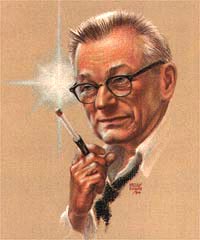The directory «Plots»
Campbell John Wood Jr.
(1910—1971)

John Wood Campbell, Jr. was an important science fiction editor and writer. As a writer he was first influential under his own name as a writer of super-science space opera and then under the name Don A. Stuart, a pseudonym he used for moodier, less pulpish stories. However, Campbell's primary influence on the genre was as the editor of Astounding Science Fiction, a post that he held from late 1937 until his death. In that role he is generally credited with helping to create the so-called Golden Age of Science Fiction, which is often held to have started with the July 1939 issue of Astounding. Isaac Asimov called Campbell "the most powerful force in science fiction ever, and for the first ten years of his editorship he dominated the field completely." At the time of his sudden and unexpected death after 34 years at the helm of Astounding, however, his quirky personality and occasionally eccentric editorial demands had alienated a number of his most illustrious writers such as Asimov and Robert A. Heinlein to the point that they no longer submitted works to him.
Campbell was born in Newark, New Jersey in 1910. His father was a cold, impersonal, and unaffectionate electrical engineer. His mother, Dorothy (née Strahern) was warm but changeable of character and had an identical twin who visited them often and who disliked young John. John was unable to tell them apart and was frequently coldly rebuffed by the person he took to be his mother. Campbell attended the Massachusetts Institute of Technology (MIT), where he befriended Norbert Wiener, one of the godfathers of computers. He began writing science fiction at age 18 and quickly sold his first stories. By the time he was 21 he was a well-known pulp writer of super-science space opera but had been dismissed by MIT: he had failed German. He then spent one year at Duke University, from which he graduated with a Bachelor of Science in physics in 1932. Asimov notes Campbell's presence at Duke and speculates that Duke was "best known in my youth for the work of Joseph B. Rhine on extrasensory perception, and that may have influenced Campbell's later views on the subject." Damon Knight writes that Campbell was a "portly, bristled-haired blond man with a challenging stare" who told him once that "he wasn't sure how much longer he would edit Astounding. He might quit and go into science. 'I'm a nuclear physicist, you know,' he said, looking me right in the eye." He was married to Dona Stewart in 1931, divorced in 1949, then remarried in 1950 to Margaret (Peg) Winter. He spent most of his life in New Jersey and died at home, "quietly, quickly, painlessly, as he sat before his television."
Campbell's first published story, "When the Atoms Failed", appeared in the January 1930 issue of Amazing Stories, when he was 18; he had had a previous story, "Invaders from the Infinite", accepted by Amazing's editor, T. O'Conor Sloane, but Sloane had lost the manuscript. Campbell's early fiction included a space opera series based around three characters, Arcot, Morey and Wade; and another series with lead characters Penton and Blake. All were eventually published in book form in the 1950s and 1960s. This early work established Campbell's reputation as a leading writer of space adventure; and when he began in 1934 to publish stories with a different tone, he used a pseudonym, Don A. Stuart.
Soon Stuart also had a strong reputation as a leading writer, and from 1930 until the later part of the decade Campbell was prolific and successful under both his own name and the Stuart pseudonym. Two significant stories published under the pseudonym are "Twilight" (Astounding, November 1934), the first Stuart story, which immediately established the reputation of the apparently new author; and "Who Goes There?" (Astounding, August 1938), about a group of Antarctic researchers who discover a crashed alien vessel, complete with a malevolent shape-changing occupant. This was filmed as The Thing from Another World (1951) and again as The Thing (1982). "Who Goes There?", published when Campbell was only 28, was his last significant piece of fiction. As Sam Moskowitz has written about Campbell in his early critical study of science-fiction writers, "From the memories of his childhood he drew the most fearsome agony of the past: the doubts, the fears, the shock, and the frustration of repeatedly discovering that the woman who looked so much like his mother was not who she seemed. Who goes there? Friend or foe?".
Sierra Leone, 1996, Drowned City